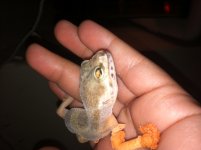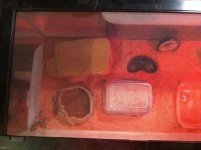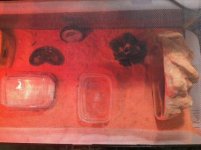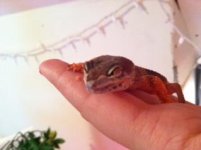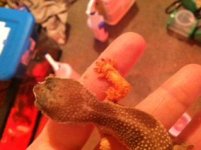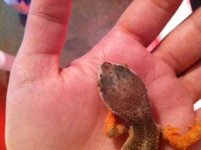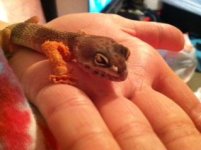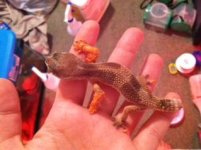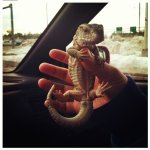I dont know what the substrate is, except that it's orangeish-peach colored sand, the type you would get from Petco. We had planned to get some kind of real sand, but paper towels sounds like a much better idea. The tail definitely isnt a new wound, the owner said that it just 'never grew in,' but it's obvious that it just dropped. Is it common for them to drop tails like other geckos do?
General Information
Species of lizard:
Leopard Gecko
Gecko's name:
Bender
Morph:
N/A
Gender:
Unknown
Age:
Unknown- I would assume young since he is really tiny.
Weight:
10.8 grams.
Total length:
Four inches- give or take.
Length of your reptile when you first acquired it:
Same as above.
Source (pet store, breeder, previous owner):
A previous owner, he got it from Petco.
Captive bred or wild caught: I would assume Captive Bred.
Vivarium
Enclosure dimensions (length x width x heighth):
20 long aquarium.
Cage (type, size):
Glass.
Substrate provided:
Peach colored sand.
Types of hiding places provided:
Two rock enclosures.
Is there a humidity hide? location?
In the middle of the enclosure.
Please describe any other furnishings:
There's a tree, haha.
List recent changes in the environment, if any:
We moved him from his previous owner to here, and added a humid hide and a little pool.
Lighting
Artificial lighting
Incandescent (“screw-in” bulbs): wattage(s):
40W
Fluorescent (tube bulbs):
Natural lighting
Access to ambient daylight from a distant window:
There is.
Heating
Do you have a thermometer(s) in the cage?
Yes.
What type and brand of thermometer (digital with probe, temperature gun, LCD strip, analog (circle), combo digital thermometer/hygrometer, stainless steel aquarim type, other):
A dual circle hydrometer and thermometer.
What is the ground temperature right on the substrate under the warm dry hide:
about 70.
What is the air temperature on the warm end about 4 inches up from the ground:
about 70.
What is the air temperature on the cool end about 4 inches up from the ground:
about 70.
What device(s) are used to maintain the temperature (Under Tank Heater, heat light, ceramic heat emitter, Flexwatt heat tape, hot rock, other):
Heat lamp.
Ventilation space for your UTH by elevating the tank above the shelf (some UTHs come with sticky feet for the tank corners):
Are you using a thermostat(s)?
No.
Which hide does she/he spend most of her time?
A rock to the left of his container.
Is the temperature decreased at night? by how much?
Not really.
Humidity
Is the humidity measured?
it says about 10%
Humidity range:
0-100%
Diet
Insects and worms, list type:
Mealworms
Regular diet fed to the insects and worms:
The stuff they come in from the store.
Are the insects and worms formally “gutloaded” 1-2 days prior to feeding off to your gecko? If so with?
No. (what does that mean?)
How often do you feed your gecko?
Since yesterday he's had a constant food source.
Please list any supplements (with brand names) used. How are they given and how often?
None.
What calcium brand are you using? with D3, without or both?
None at the moment.
Is the calcium in the tank with D3 or without?
N/A
Multivitamins (include brand name)?
N/A
Please list any recent additions/changes in the diet:
I think he was eating dried Mealworms, so at this point he's eating live.
General Health
If your gecko is sick, please describe the signs and how long your gecko has been showing these signs:
None.
Is your gecko’s general activity level normal, decreased, or increased?
He seems to be acting okay.
Is your gecko’s appetite normal, decreased, or increased?
Not sure.
Have you noticed any of the following?
Weight (loss or gain):
No.
Discharge from the eyes or nose:
No.
Increased breathing rate or effort:
No.
Change in the droppings:
No.
Urates
---white or yellowish:
N/A
---size of urates as compared to size of feces:
N/A
Abnormal skin color or shedding:
about two layers of stuck she d on his legs, some on his eyes as well.
Parasites on the skin or in the feces:
None.
Weakness:
None.
Previous problems and/or illnesses:
Other Critters in Same Cage or in Household
List other animals that are kept in the same cage:
None.
Recent acquisitions (new pets within the past 6 months):
All of them? haha. 14 snakes, a Savannah Monitor, two Tokay Geckos, a Halmahera Gecko, and a Crested Gecko.
Are any of your other pets ill?
None.
Pictures of him and his enclosure as asked:
